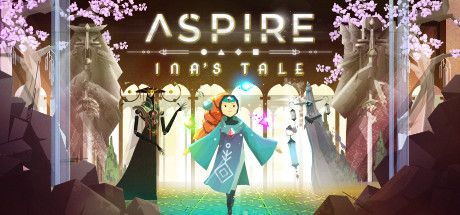Aspire: Ina’s Tale
If you catch a glimpse of someone playing Aspire: Ina’s Tale, you might get the impression that it's Gris. But a closer look will quickly put everything in its place and let you know: no, it's not that at all. And here's a good one — Question.
The source of inspiration for the developers from Wondernaut Studio is immediately apparent. Not only that, but it is strikingly obvious and strongly emphasized in every possible way. The main character solves her problems and uncomplicated puzzles as she travels through beautiful worlds. But where Gris had everything perfect, here it turns out so-so — and vice versa. The picture in Aspire: Ina’s Tale is not as calibrated and not at all breathtaking. You can see that they tried, but the finesse of the object of inspiration is nowhere to be seen. In Gris you could put every screen on the desktop, but here the player is met with just a ruin, just a forest or just a factory. The heroine is just as sketchy, but her face is more like Vasilisa from Black Book, and she is shown only as a model, and this image always looms before our eyes. The authors didn't have enough artistic talent to repeat Gris, even though they really wanted to. It's the same with the music: it's not bad, but there's not much symbiosis with the artwork.
As for the plot and puzzles, however, the situation is better. The storyline is simple, but still there. And there are several characters and dialogues — not voiced, true, but the text is enough to understand the story and the clear goals that the heroine is striving for.
The puzzles are simple, but fairly numerous, and Aspire: Ina’s Tale feels like a game, not an interactive installation. During her journey, Ina finds three kinds of spirits (yes, the glowing things flying around again): energy, movement, and growth. You can use the former to power up various sources, or transfer it to a crate and push it wherever you want (pushing crates is something the authors generally love). The next type of spirit is responsible for the movement of platforms and the like, and the segment with it has riddles for time — not everyone likes it, but at least they create some sense of complexity. Riddles are not difficult, but sometimes they are not solved quickly and make you think, slowly passing from using one type of spirits to using the whole trinity of spirits.
Also, to make life seem like a dream, Aspire: Ina’s Tale added a few moments of running away from the monster. Yeah, just like in Gris, only if there you can do nothing at all, here you can be eaten, and at the very end of it you have to fight the boss in three stages — solving problems with hiding in the closet.
From the obligatory program in various corners hidden in the memories of a few characters, which you can then discuss with them same. Not bad, but in places the gathering turns into a drag on the game through backtracking, and that's hardly worth it.
Wondernaut Studio only formed in 2020, but is already releasing Aspire: Ina’s Tale. The studio is small, not much time has passed, and therefore the game is short and rough. It doesn't really evoke much emotion, despite the fact that it constantly talks about the heart. And if you look at the Gris score, you'll see the same score as here, but it's actually quite different. Aspire is a pale copy of Gris, but with gameplay and a clear story. It's enough for someone.
